Nikkei Farmers of the Hood River Area
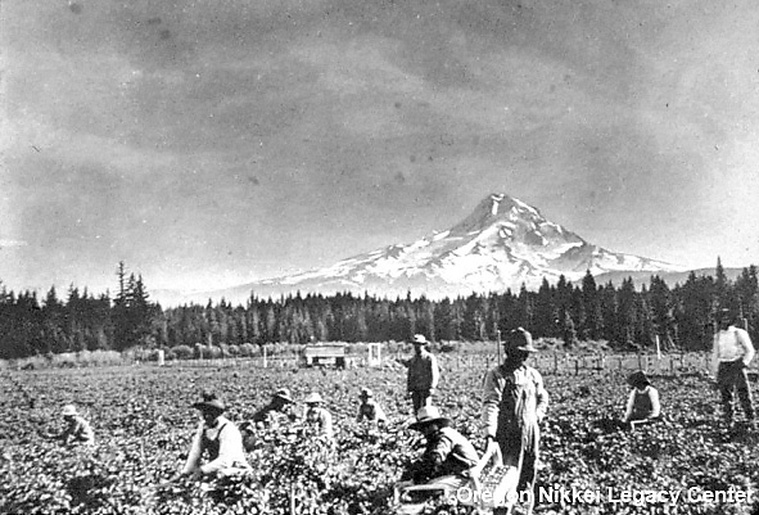
|
||
| Licensing | ||
The Nikkei community of Hood River was one of the largest and earliest established Japanese communities in the state of Oregon. Agriculture has been a significant part of the culture which is still carried on today by many families, but this history required integration, struggle and perseverance. This collection is a brief history of Nikkei farmers of the Hood River area, presented by the Oregon Nikkei Legacy Center. Please contact ONLC for additional information. Thank you to the Nikkei families of the Hood River area, Linda Tamura, the Yasui Family, and the Hood River County Historical Museum for their participation in the original exhibition. This project has been funded in part by the Oregon Heritage Grant.
Slides in this album |
|

|
Hamada Family Orchard, Parkdale, OR, ca. 1920.Japanese began to arrive in the Hood River area by 1900. Hopes and dreams brought them to this verdant valley along the Columbia River. The promise of a better life in America, adventure, new opportunities –- Issei, the first generation, had courage and determination in common. They traveled from many …
Hamada Family orchard, Parkdale, Oregon, ca. 1920 |
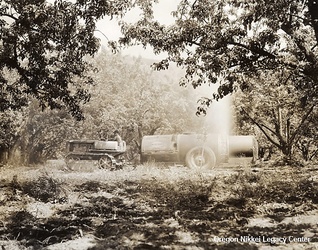
|
Working the OrchardThe primary Japanese farming communities of the Mid-Columbia region were located in Oregon's Hood River valley at Dee, Odell, Parkdale, Pine Grove, and Oak Grove. In Wasco County, farming took place in Mosier and The Dalles. A few families farmed across the Columbia River in Dallesport and Bingen, in Klickitat …
Kiyokawa orchard |
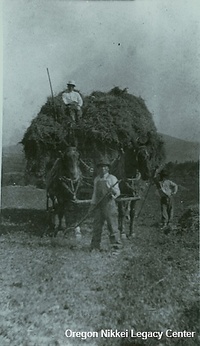
|
Loading Hay on the Hamada FarmSome came from traditional farming backgrounds in Japan, but not everyone had experience. They took what work they could get. Mostly young, single men, the first Issei were employed at hard labor. Shinbo –- the Japanese principal of patience, endurance, and perseverance –- guided their paths. By 1900, 2,500 Japanese …
Hamada farm workers |

|
Kanshichi ItanoThe first Issei to arrive in the Hood River Valley were hired on contract as railroad laborers. Kanshichi Itano and his Japanese crew built the Mt. Hood Railroad from the town of Hood River to Dee, and later extended it to Parkdale. The line transported lumber, passengers, and early apple …
Kanshichi Itano |
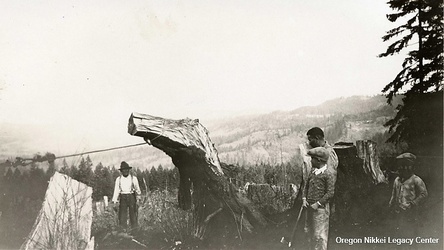
|
Clearing Land of Timber, Hood River, OR, ca. 1927Issei were also hired to clear land for landowners. After timber harvest, stumps were pulled with horses, dynamite, and hard labor to prepare fields for planting. By 1905, as many as 600 Issei were employed in this manner, for about a dollar a day. As Issei laborers saved money and …
Clearing stumps, Hood River |
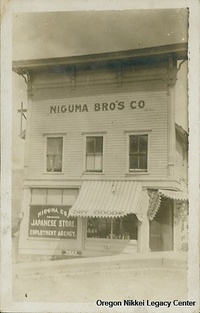
|
The Niguma Variety Store, Hood River, ORThe Niguma Variety Store opened in Hood River in 1905 on the corner of First and Oak Streets, and included a mailhouse, Japanese social center, boardinghouse and brothel. Brothers Renichi Fujimoto and Masuo Yasui purchased the Niguma family business around 1913. However, the Yasui Brothers enterprise really began in 1908 …
Niguma Brothers Store, Hood River, Oregon |
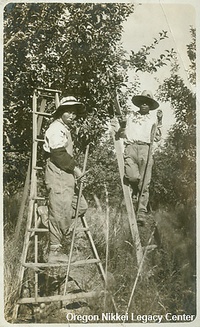
|
Dee, OR, ca. early 1920sAs livelihoods became more certain, men sent for their wives. The Issei women were often surprised by their circumstances but persevered, working alongside their husbands, often in very rustic conditions. Marriages were almost always arranged, as was the custom in most Japanese families. Sometimes the bride and groom did not …
The Yasui Farm in Dee, Oregon |

|
Strawberry packing shed, Hood River, OR, ca. 1916Agriculture is a complex business. Growers must contend with the vagaries of constantly changing climate and markets. Issei joined the local apple growers associations to facilitate getting their crops to market. The Hood River Apple Growers Union and the Hood River Apple Growers Association, formed in 1913, were cooperatives for …
Strawberry Packing, Hood River, Oregon |
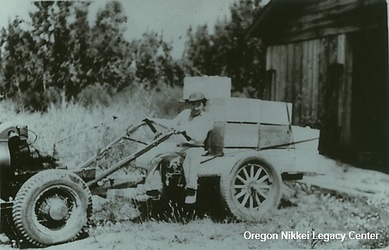
|
Hauling Asparagus, ca. 1935It takes about nine years for apple trees to bear enough fruit for commercial harvest. Families planted their orchards, and put in strawberries for quick cash crops. In 1920, 351 Japanese lived in Hood River, and produced 75 percent of the valley's strawberries. About 70 Issei owned 1,200 acres and …
Hauling asparagus |
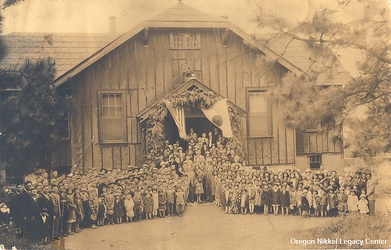
|
Hood River Community Hall, 1929Completed in 1926, the Hood River Japanese Community Hall became a central place for community life. Plays, musicals, talent shows, Japanese picture shows, community meetings, Christmas and New Year's parties, Japanese School, and Japanese Methodist Church services were all held at the new facility. The Dee Japanese Community Hall was …
Community Hall, Hood River, Oregon |

|
Fourth of July, Parkdale, OR, ca. 1935The Issei felt their roots sinking into the American soil. Their children were American citizens. Integrating into the mainstream of American life was not always easy despite the hard work by the Hood River area Japanese. Successes were met with resentment and intolerance. Gambatte –- "Stick to it, don’t give …
Fourth of July, Parkdale, Oregon, ca. 1935. |
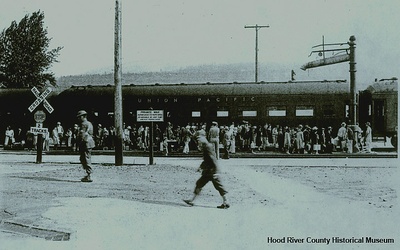
|
Hood River, OR, 9:40 a.m., May 13, 1942Some of the Japanese in the valley were at the Japanese Community Hall on Sunday, December 7, 1941, preparing for a variety show when news of the Pearl Harbor bombing came on the radio. Japanese homes were searched. Men were taken away and their families waited weeks, months, even years …
Hood River, Oregon, 9:40 a.m., May 13, 1942. |
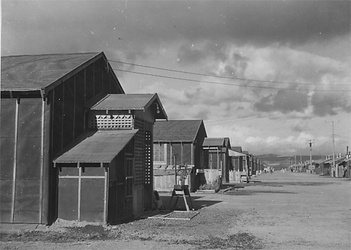
|
Tule Lake Residential BarracksFrom Pinedale, most of the families were sent to a concentration camp at Tule Lake, near the Oregon-California border –- one of ten War Relocation Camps administered by the War Relocation Authority. Tule Lake later became the only "segregation camp," where the so-called "disloyals" were transferred from the other nine …
Tule Lake Barracks |
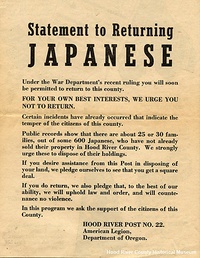
|
Statement Published in the Hood River News, December 22, 1944At the war's end, families faced difficult decisions on where to go next -- many had to begin anew. Forty percent of the Nikkei community members returned to the area after World War II. Many families had nothing to go back to. They had lost everything that was home in …
Statement to Returning Japanese, Hood River, Oregon, 1944 |
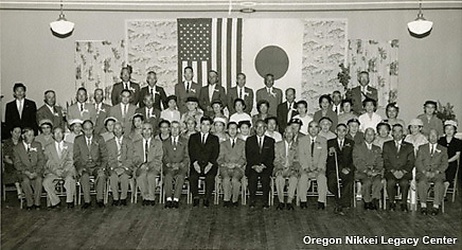
|
Naturalization Ceremony, June 3, 1960The McCarran-Walter Immigration and Naturalization Act passed in 1952, allowing Issei to apply for and receive American citizenship after so many years. The Civil Liberties Act of 1988 provided for an apology and public acknowledgment that the U.S. Government's incarceration of Japanese Americans was wrong, found to be based on …
Naturalization Ceremony, June 3, 1960 |
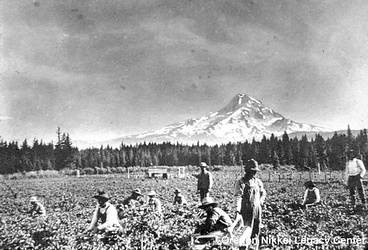
|
Picking Strawberries near Mt. Hood, OregonMany Nikkei families still farm in the Hood River area, but the dynamics have changed. Children choose other lines of work. People work at professional jobs and keep the farm operations going, not relying solely on income from their crops. Families have diversified with changing times. Organic produce is being …
Picking strawberries |
 Oregon_Nikkei
Oregon_Nikkei
 Taken: Oregonians Arrested after Pearl Harbor
Taken: Oregonians Arrested after Pearl Harbor Nikkei Farmers of the Hood River Area
Nikkei Farmers of the Hood River Area Nihonmachi: Portland's Japantown
Nihonmachi: Portland's Japantown
 Journal feed
Journal feed
